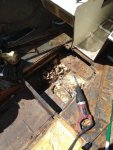The Car Doctor
Cadet
- Joined
- Aug 21, 2009
- Messages
- 19
My boat is a 19' Four Winns Horizon and this summer I've noticed the lovely decomposing wood smell every time I opened the ski locker. Now that the season is over, I've decided to spend the winter working on it. After opening things up, I found water logged foam under the floor of the ski locker and the fuel tank. The keel stringer is soaking wet and falling apart. It seems to me like this is a lousy place to put in foam. Shouldn't very bottom of the boat should allow water to drain freely into the bilge.
My question is what if I leave the foam out of this after my rebuild? Also, what if I left the floor out of the ski locker to give me a few more inches storage space? Would it be bad to have stuff stored directly to the bottom of the hull?
My question is what if I leave the foam out of this after my rebuild? Also, what if I left the floor out of the ski locker to give me a few more inches storage space? Would it be bad to have stuff stored directly to the bottom of the hull?






















